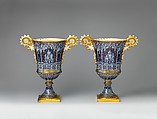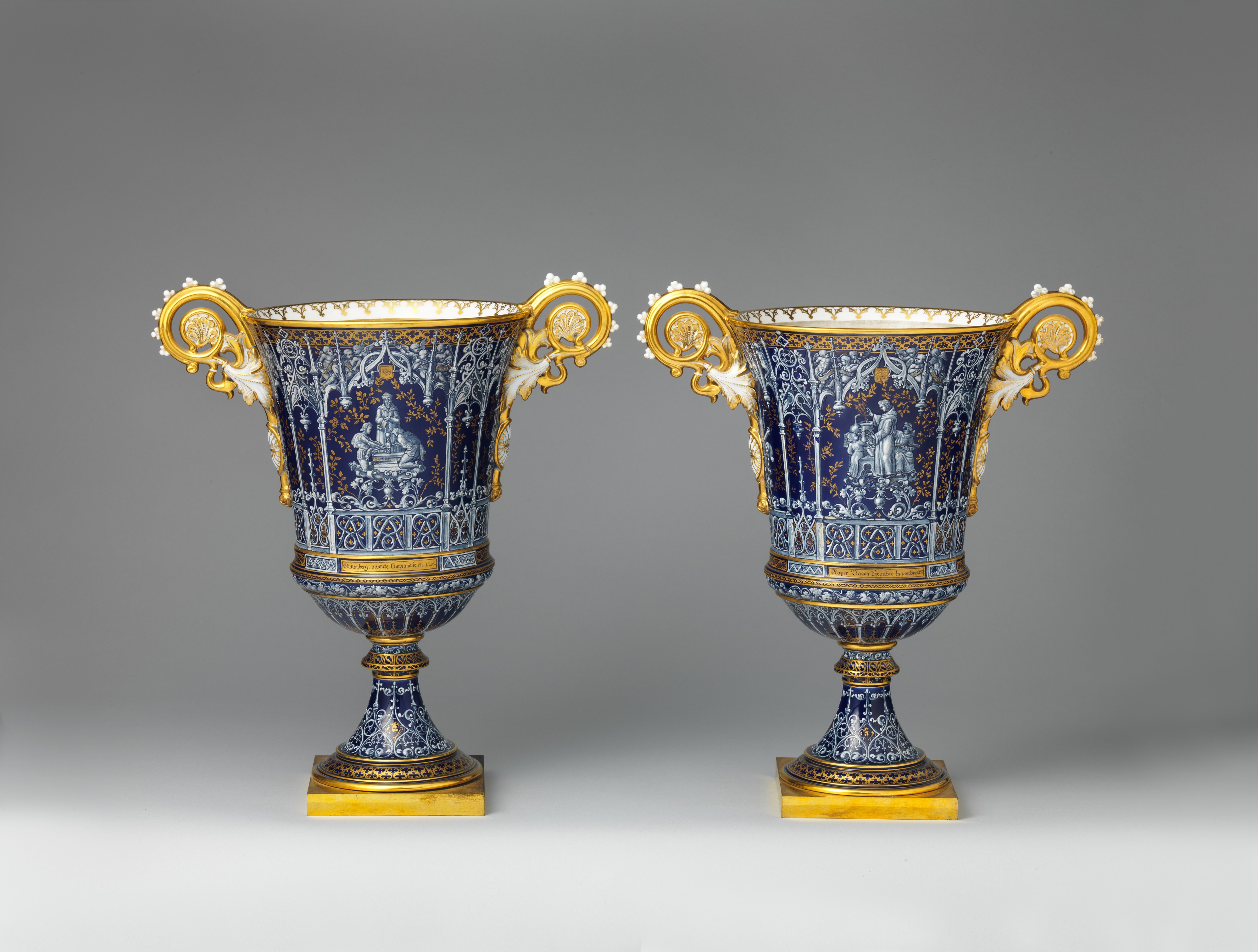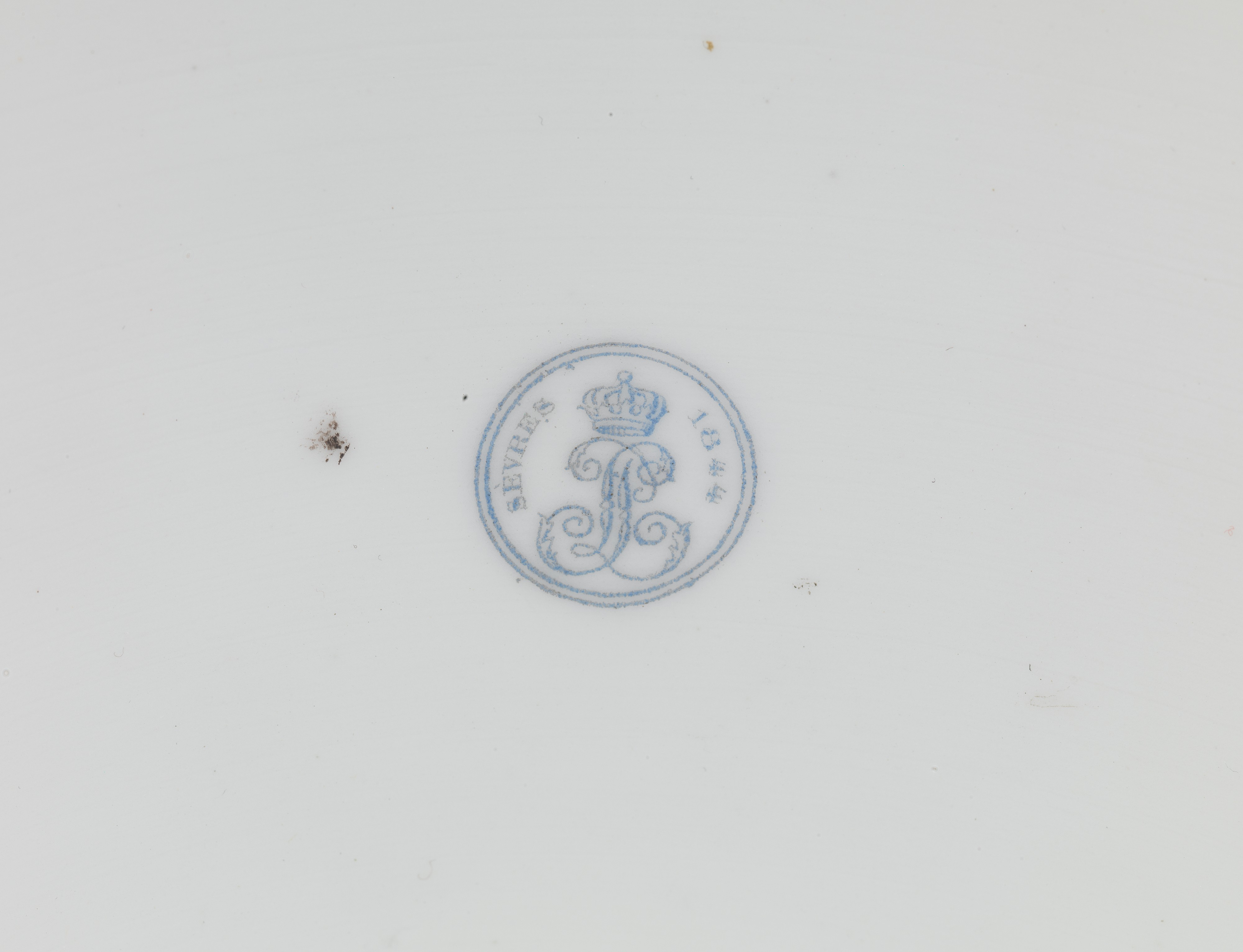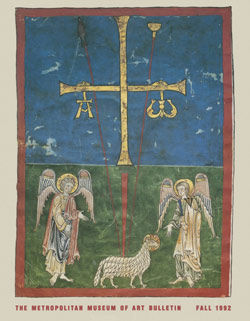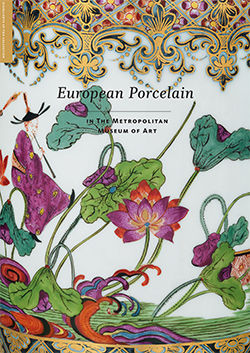Vase (vase gothique Fragonard) (one of a pair)
Manufactory Sèvres Manufactory French
Model designed by Alexandre Evariste Fragonard French
Decorator Jacob Meyer-Heine French
These two vases decorated in the neo-gothic taste embody the eclecticism that characterizes so much of the art produced in mid-nineteenth-century France. The model for this vase was designed by Alexandre-Évariste Fragonard (French, 1780–1850), one of the most prolific designers at the Sèvres factory during the 1820s and 1830s. Given the title vase gothique Fragonard at Sèvres, the model transforms a Medici vase shape (entry 74) with the addition of prominent scrolling handles that are embellished with trefoils and stylized vegetation in low relief.[1] The elaborate profile of the handles diminishes the essentially Neoclassical character of the vase’s form, and instead, the form com-bines harmoniously with the painted neo- Gothic decoration to suggest, however loosely, a work of art made in the late fifteenth century.[2] Nonetheless, the Gothic quality of the vase’s design is slight. When the model was exhibited shortly after its introduction at the 1823–24 New Year’s exhibition at the Musée du Louvre in Paris, and during the years in which it was in production, it was described as having a twelfth- century form and decorated in a variety of styles in addition to neo-Gothic.[3]
The Museum’s vases are painted in gray and white with gilt high-lights on a dark blue ground in a manner that intentionally evokes Limoges enamels from the sixteenth century. This stylistic borrowing was acknowledged at the factory where the painters’ records describe these vases as “in imitation of Limoges enamels,”[4] and it is testimony to the designers and painters at Sèvres that the late Gothic and Renaissance styles are synthesized seamlessly.[5] The decorative scheme of the two vases celebrates four significant inventions or discoveries by portraying the four men believed to be responsible for these accomplishments. On one vase Nicolaus Copernicus (Polish, 1473–1543) and Johann Gutenberg (German, ca. 1398–1468) are depicted on the two sides, and a band below each figure indicates the discovery of the planetary system and the invention of the printing press, respectively. The other vase portrays Roger Bacon (English, ca. 1214–1292) and Flavio Gioja, or Gioia (Italian, early 14th century), with the bands below crediting the invention of gunpowder and of the compass,[6] respectively. The four figures, each accompanied by two assistants, stand within Gothic arches that evoke choir screens, and the blue ground of each vase is painted with a wealth of Gothic tracery and gilt highlights throughout. As has been observed by Clare Le Corbeiller, the profusion and variety of ornament on the vases have been executed with a degree of order that gives the overall composition a certain lightness and legibility despite the abundance of detail.[7]
Alexandre Brongniart (French, 1770–1847), the director of the factory, was keenly interested in chemistry, technology, and scientific matters in general, and he would have determined the subject matter for the vases. In addition, Brongniart would have selected their decorative style. The Gothic revival in France was in its maturity when these works were painted, and they are among the most overtly neo-Gothic works produced at Sèvres. While other historic revival styles, especially the neo- Renaissance, were more popular at the factory, those made in the Gothic style fully embraced the motifs associated with the late Gothic period. Two cups and saucers from 1816 are among the earlier works produced at Sèvres in this style,[8] and more designs in this idiom were produced until the 1840s.[9]
A distinguishing feature of these vases is the use of a technique associated with Renaissance metalwork to execute Gothic motifs on porcelain. It has been suggested by Bernard Chevallier the Louvre’s acquisition of collections in the 1820s that included Limoges enamels stimulated interest in this material,[10] and a gueridon (pedestal table) made at Sèvres in 1830 is among the earliest works to employ Limoges-style decoration on porcelain.[11] The development of this technique at Sèvres is closely linked to the factory painter Jacob Meyer- Heine (French, 1805–1879), who had trained as an enameler prior to his employment at Sèvres.[12] Meyer- Heine’s first work in the Limoges-enamel style on porcelain appears to be on a vase dated 1840–41,[13] and he decorated a series of vases in the early 1840s, including those under discussion, in this technique.[14] Brongniart’s interest in the process of decorating porcelain using this style led to the creation of a new workshop at Sèvres devoted to enameling on copper. With the support of French King Louis- Philippe (1773–1850), Brongniart established the specialized workshop specifically to “produce works enameled in the manner of the Limousins,”[15] and Meyer- Heine was appointed as its head in 1845. Due to the new focus of enameling on copper at Sèvres, the factory ceased to employ this technique for the decoration of porcelain, and the Museum’s vases are among the last works produced in this style.
The pair of vases entered the factory salesroom on December 31, 1844.[16] In April 1845 the two vases were delivered to Louis- Philippe to be presented as gifts,[17] though the intended recipient is unknown. In their use of Gothic motifs and a Renaissance- inspired technique to pay homage to historical figures who lived over a span of four centuries, the vases artfully reflect the century’s fascination with the past as an infinite resource to be mined for both content and style.
Footnotes
(For key to shortened references see bibliography in Munger, European Porcelain in the Metropolitan Museum of Art. NY: The Metropolitan Museum of Art, 2018)
1 This pair of vases has been published in detail by Clare Le Corbeiller, and I am much indebted to her research and observations. See Le Corbeiller 1999a.
2 Equally successful aesthetically are a pair of vases gothique Fragonard with similar decoration in Entre cour et jardin 2007, p. 189, no. 188, ill.
3 Tamara Préaud in Préaud et al. 1997, p. 299.
4 Archives, Cité de la Céramique, Sèvres, Vj’ 51 (1844), fol. 72, Meyer.
5 Le Corbeiller 1999a, p. 146.
6 Extremely little is known about Flavio Gioja, and his role, if any, in the invention of the compass is uncertain; ibid., pp. 148–50. 7 Ibid., p. 147.
8 Préaud in Préaud et al. 1997, pp. 356–57, nos. 142a, 142b.
9 Préaud in ibid., pp. 298–99, no. 97.
10 Chevallier 1991, p. 57.
11 Le Corbeiller 1999a, p. 147.
12 For an in- depth study of Meyer- Heine, see Massé 2011.
13 Faÿ-Hallé and Mundt 1983, ill. no. 198.
14 For example, see a pair of vases Adélaïde of 1844 now in the Musée du Louvre, Paris (Pierre Ennès in Âge d’or des arts décoratifs 1991, p. 410, no. 231), and a coupe Henri II, 1842–43, in the Wadsworth Atheneum, Hartford, Conn. (Roth 2007, p. 213).
15 “la fabrication des pièces émaillées à la manière des Limousins”; Exposition des manufactures royales 1846, p. 31, quoted by Ennès in Âge d’or des arts décoratifs 1991, p. 410.
16 Archives, Cité de la Céramique, Sèvres, Vv 4, fol. 34, no. 15 (feuille no. 80).
17 Archives, Cité de la Céramique, Sèvres, Vbb 11, fol. 2v, April 24, 1845, priced at 750 francs each.
Due to rights restrictions, this image cannot be enlarged, viewed at full screen, or downloaded.
This artwork is meant to be viewed from right to left. Scroll left to view more.
